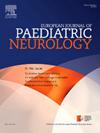Co-occurring impairments in several domains of memory following neonatal hypoxic-ischaemic encephalopathy have real-life implications
IF 2.3
3区 医学
Q3 CLINICAL NEUROLOGY
引用次数: 0
Abstract
Background
Neonatal Hypoxic-Ischaemic Encephalopathy (HIE) increases the risk for neurodevelopmental impairment. Information on school-age memory function is limited in children who received hypothermia treatment (TH) for neonatal HIE.
Objectives
To evaluate memory function in school-aged children who had neonatal HIE and TH and survived without major neuromotor impairment.
Method
Fifty-one children with neonatal HIE and 41 typically developing (TD) peers participated. At age 6–8 years general cognitive abilities (FSIQ) were assessed with Wechsler Intelligence Scale for Children (WISC-V), immediate and delayed visual and verbal memory with Children's Memory Scale (CMS), everyday memory with Rivermead Behavioural Memory Test for Children (RBMT-C), and working memory with WISC-V. Real-life implications were assessed with Behavior Rating Inventory for Executive Function (BRIEF; Parent and Teacher). Group differences were examined and correlations calculated to assess associations between memory measures. Relationship maps illustrate co-occurring impairments.
Results
FSIQ was in the normal range for both groups but significantly lower in the HIE group. Children with HIE had significantly more deficits in working memory (20.4 % vs 0 %), verbal immediate (20.0 % vs 2.5 %), verbal delayed (17.8 % vs 2.5 %), visual immediate (28.9 % vs 7.5 %), and everyday memory (38.8 % vs 5.6 %). Relationship maps identified more co-occurring clinical/borderline impairments in children with HIE (45.1 % vs 4.9 %) and more frequent clinical impairments in real-world memory measures.
Conclusion
Despite hypothermia treatment, and with general cognitive abilities in the normal range, children with neonatal HIE are at risk of memory impairments in multiple domains, affecting everyday functioning at home and school. Timely identification is important for individually targeted support.
新生儿缺氧缺血性脑病后几个记忆领域共同发生的损伤具有现实意义
背景新生儿缺氧缺血性脑病(HIE)增加神经发育障碍的风险。接受过低温治疗(TH)的新生儿HIE患儿的学龄记忆功能信息有限。目的评价新生儿HIE和TH学龄儿童无重大神经运动障碍存活后的记忆功能。方法对51例新生儿HIE患儿和41例正常发育(TD)患儿进行调查。6 ~ 8岁时,采用韦氏儿童智力量表(WISC-V)评估一般认知能力(FSIQ),采用儿童记忆量表(CMS)评估即时和延迟视觉和言语记忆,采用Rivermead儿童行为记忆测验(RBMT-C)评估日常记忆,采用WISC-V评估工作记忆。使用执行功能行为评定量表(BRIEF;家长和老师)。研究人员检查了组间差异,并计算了相关系数,以评估记忆测量之间的关联。关系图说明了共同发生的损伤。结果两组患者fsiq均在正常范围内,HIE组明显低于对照组。患有HIE的儿童在工作记忆(20.4%比0%)、语言即时(20.0%比2.5%)、语言延迟(17.8%比2.5%)、视觉即时(28.9%比7.5%)和日常记忆(38.8%比5.6%)方面的缺陷明显更多。关系图显示HIE儿童的临床/边缘性损伤发生率更高(45.1%比4.9%),真实记忆测量的临床损伤发生率更高。结论新生儿HIE患儿尽管接受过低温治疗,认知能力在正常范围内,但仍存在多领域记忆障碍的风险,影响其在家庭和学校的日常功能。及时识别对于个别针对性的支持很重要。
本文章由计算机程序翻译,如有差异,请以英文原文为准。
求助全文
约1分钟内获得全文
求助全文
来源期刊
CiteScore
6.30
自引率
3.20%
发文量
115
审稿时长
81 days
期刊介绍:
The European Journal of Paediatric Neurology is the Official Journal of the European Paediatric Neurology Society, successor to the long-established European Federation of Child Neurology Societies.
Under the guidance of a prestigious International editorial board, this multi-disciplinary journal publishes exciting clinical and experimental research in this rapidly expanding field. High quality papers written by leading experts encompass all the major diseases including epilepsy, movement disorders, neuromuscular disorders, neurodegenerative disorders and intellectual disability.
Other exciting highlights include articles on brain imaging and neonatal neurology, and the publication of regularly updated tables relating to the main groups of disorders.

 求助内容:
求助内容: 应助结果提醒方式:
应助结果提醒方式:


